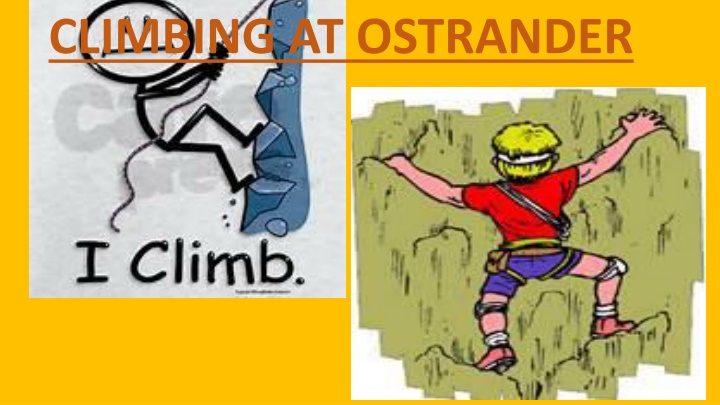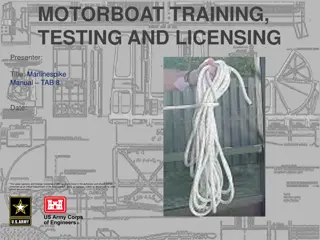Essential Climbing Knots and Techniques for Beginners
Learn the key climbing knots like the Figure Eight Follow Through and the Figure Eight On A Bight, essential for beginner climbers. Follow step-by-step instructions, safety tips, and technical information to enhance your climbing skills and knowledge.
Download Presentation

Please find below an Image/Link to download the presentation.
The content on the website is provided AS IS for your information and personal use only. It may not be sold, licensed, or shared on other websites without obtaining consent from the author.If you encounter any issues during the download, it is possible that the publisher has removed the file from their server.
You are allowed to download the files provided on this website for personal or commercial use, subject to the condition that they are used lawfully. All files are the property of their respective owners.
The content on the website is provided AS IS for your information and personal use only. It may not be sold, licensed, or shared on other websites without obtaining consent from the author.
E N D
Presentation Transcript
Figure Eight Follow Through If you are a beginner climber and can only remember one knot, let it be this one. I'd be very surprised if any climber did not know this knot. Among other uses, it's very popular as a "tie in" for attaching the climbing rope to your harness. With that in mind, follow these steps to "tie in" with the Figure Eight knot: Step 1 (Click To Enlarge) Step 2 (Click To Enlarge) Step 3 (Click To Enlarge)
Step 1: Form a single figure eight in the end of the rope and feed the tail through your harness. Some harnesses require that you feed the rope through certain straps. When tying in, I like to feed rope through the same harness straps that the belay loop occupies (not pictured), others prefer to use the belay loop (as pictured). Still others prefer to tie into a steel locking carabiner, or two aluminium locking carabiners, gates reversed, which have been clipped into the appropriate harness straps. There are pros & cons. Consult your harness manual for the recommended tie in point. Steps 2 & 3: Rethread the figure eight, following the same path as the first. Pull the knot tight (though some climbers prefer to leave it a little loose to absorb force from a fall). Make sure you have enough tail, as the knot will slip a bit when loaded. Check the knot by counting "two", "two" & "two", for the three visible doubled strands. Ensure they each are lying flat and not crossing over themselves. Step 4: An optional step. If you find yourself with too much tail, or are paranoid about the figure eight slipping, tie a stopper knot with the remaining tail. It is recommended that you check your partner's tie in knot, and get them to check yours before climbing.
Steps 1,2 & 3: Grab a bite of rope and form the classic figure eight. Step 4: Pull tight and clip in. Fast, simple and secure Figure Eight On A Bight This knot is formed from a "bight" of rope. It's very handy to just grab a bight of the rope anywhere along it and tie it off in this manner. Useful for belay set ups, or rescue work, or to backup ascending a rope, and all sorts of applications. Again, I'd be very surprised if any climber did not already know this knot. Never-the-less, follow these steps to tie a figure eight on a bight:
GENERAL TECHNICAL INFORMATION FOR RU-ABLE (Equipment and Skills) 1. Knot parts: Stand end, running end, bight, loop (Ropes typically fail (break) where standing end enters) Therefore: We dress our knots so they are neat and snug. Messy knots compromise strength. 1. Knots: a. Figure 8 follow-through and figure 8 on a bight - a classic know used to tie directly into a climbing harness, first acceptable way to connect a participant to a dynamic belay. b. Double Figure 8 used to clip into a harness on the ABLE challenge course, second acceptable way c. Butterfly Knot used for team belays d. Double Bowline used as third acceptable way to connect participant to a belay, must be backed up 1. Two types of climbing ropes: a. Low Stretch Rope: (Static) 5% or less stretch fibers parallel - static rope used for flying squirrel and rappel b. High Stretch Rope: (Dynamic) 7 10% stretch fibers twisted climbing ropes used to belay on high elements c. Kernmantle vs. twisted rope (nitro crossing ropes are twisted and climbing ropes are kernmantle)
dangerous as opposed to dynamic belays. 9. Climbing Techniques: (Use these tips when helping a participant climb!!!!) a. Maintain 3 points of contact b. Use largest muscles of body to your advantage (climb with legs) c. Breathe!! Plan each move pick individual route d. Keep weight over feet (try not to hug wall) 9. Static belay a. Use of lobster claws on the ABLE course (function of zorber to minimize shock of fall so not to exceed 900 lbs.) b. Inspection of lobster claws 9. Course inspection and hardware a. Know hardware (names and function) b. Know basic inspection principles for hardware c. Staples d. Rapid Links e. Telephone Poles f. Lumber g. Cable (3/8 inch, Galvanized 7x19 flexible aircraft cable) h. Serving sleeve (protects end of cable or cable may be capped) i. Thimble
-The term "belay" also means the place where the belayer is anchored -Belaying refers to a variety of techniques climbers use to exert friction on a climbing rope so that a falling climber does not fall very far. -Belay To protect a roped climber from falling by passing the rope through, or around, any type of friction enhancing belay device
Belay device A mechanical device used to create friction when belaying by putting bends in the rope. Belay Loop The strongest point on the harness. Belay on Called by belayer to confirm belay has been (re)applied to climbing rope. Response to On belay request.
Bosun's chair To reduce pains from heavy-duty climbing using a harness; such as long-time belaying or bolting a new route, climbers attach their harness with a special type of chair, which is usually light and has multiple high endurance straps and buckles. Similar types are also used in industrial climbing.
Bouldering The practice of climbing on large boulders. Carabiner Metal rings with spring-loaded gates, used as connectors. Usually oval or roughly D shaped. Also known as crab or biner Chalk A compound used to improve grip by absorbing sweat
Dynamic rope A slightly elastic rope that softens falls to some extent. Also tend to be damaged less severely by heavy loads Fall To unintentionally descend under the influence of gravity. Hopefully stopped by a rope Figure eight A belay device or descender shaped like an "8".
Figure-eight knot A knot commonly used to secure the climber's harness to the climbing rope. Helmet Also known as a brain bucket or skid lid. It can save your life, but only while worn. Hold A place to temporarily cling, grip, jam, press, or stand in the process of climbing.
Belayer - n. a person who is belaying a climber. Figure 8 - n. a common rappel / belay device shaped like the number "8". Figure 8 knot - n. Also known as the "double figure 8" or "figure 8 follow through". The most common knot used to attach the climber's harness to the rope.
Harness - n. Device the climber wears that attaches the climber to the rope so that in the event of a fall, the climber is held by the rope. (See belay.) Modern harnesses include leg loops and a waist band secured by a buckle system. They are designed to withstand far more impact force than they should ever be subjected to in use.
Knots Climbers rely on many different knots for anchoring oneself to a mountain, joining two ropes together, slings for climbing up the rope, etc. Locking carabiner A carabiner with a locking gate, to prevent accidental release of the rope. Off belay Called by a climber when requesting that the belayer remove belay equipment from the climbing rope (for example, when cleaning top protection from a lead route). Replied to with Belay off.
On belay What a climber calls when he is ready to be belayed. Replied to with Belay on. Static rope A non-elastic rope. Compare with dynamic rope. Tension A technique for maintaining balance using a taut rope through a point of protection.
Traverse 1.To climb in a horizontal direction. 2.A section of a route that requires progress in a horizontal direction. 3.A Tyrolean traverse is crossing a chasm using a rope anchored at both ends. 4.A pendulum traverse involves swinging across a wall or chasm while suspended from a rope affixed above the climber.
Rock Climbing is over 120 years old! The sport of rock climbing grew in popularity in England during the late 1880s after adventure junky William Perry Haskitt Smith made the first successful climb of the Naples Needle. People interested in sport began flocking to the region to attempt the daring feat. Smith s ascent influenced O.G. Jones in 1897 to climb Kern Knotts Crack of Great Gable Mountain. During World War II, military officers were trained in rock climbing to learn how to infiltrate enemy territories. It was also during this time that scientist invented carabiners and nylon rope to better support climbers on their mountaineering adventures.
Rock climbing has its origins in mountaineering, and was and still is, a necessary skill for reaching some of the notable summits around the world. Outdoor rock climbing is usually done when the weather is dry, as it is much more dangerous and difficult to rock climb when it is wet
Rock climbing is the act of scaling rock formations using natural hand and footholds. This individual sport grew out of mountaineering in the 1800s. During the 1950s, climbing accessories were greatly improved, and the sport's focus changed to scaling a specific rock wall rather than an entire mountain.
Rock climbing evolved into an organized sport in the 1970s, and during the 1980s indoor and outdoor climbing walls became a popular way of practicing the sport in a controlled environment.
Rock climbers are often employed to fix or maintain wind turbines, as it is usually cheaper and more efficient than using machinery to reach the turbine Rock climbers often coat their hands in chalk (magnesium carbonate), to absorb the moisture on their hands, which is said to improve their grip on the rock
Rock climbing is when one climbs, up, over, or down large rock faces that can be real or fake, including especially designed indoor rock walls, to challenge one s mind and body Rock climbing competitions usually involve trying to find the quickest way to scale a rock wall. Rock climbing began as a recognized sport in the 1880s in England
Racing to the top of a mountain or rock climbing wall is known as speed climbing. There are competitions around the world for this sport alone. Some of the more famous speed climbers include Dan Osman (Lover s Leap) and Peter Darmi (The Gunks). Mr. Everest, the tallest peak on earth, has been scaled time and time again. High winds, snow and treacherous cliffs makes Mt. Everest one of the most difficult mountains to rock climb. The current world record holder for fastest climb is Pemba Dorje Sherpa with a time of 8 hours and 10 minutes!
The true revolutionary moment was in 1980, when the Spanish company Boreal specifically focused on sticky rubber for its Fire model (Spanish, so they re pronounced fee-ray ). The Gallego brothers, who owned Boreal, even took their shoes to Yosemite and put up a new route on El Cap with them. In 1982, John Bachar already at the top of his game adopted the Fires and began selling them in the United States. Climbing standards exploded. Since then, rubber has only gotten stickier. Five Ten s Stealth Rubber has even been used in racing tires, and some of its latest incarnations are even rumored to be able to stick (barely) to tilted panes of glass. Ironically enough, many climbers consider Boreal to have some of the least sticky rubber on the market now
Many rock climbers wear special, tight, rubber soled, flexible shoes to easily grip and feel the rock beneath the climber s feet. Rock climbing usually requires special equipment, which can include gloves, a helmet, climbing ropes, harnesses, carabiners and belay devices. Rock climbing can be very dangerous, however, with the right equipment and conditions, most injuries are generally minor and are related to the fingers, shoulders and elbows.
From the 18th century to the 1930s, climbers used braided hemp or even silk ropes. They were weak, cut easily, and definitely not very dynamic. After the synthetic chemical revolution of the WWII era, nylon and perlon rapidly took the place of hemp (the fact that hemp production was restricted by the Criminalization of Cannabis may have also been a factor). However, most ropes of the 1950s-60s were still braided. The most common type of rope at this time was goldline." It was cheap and VERY dynamic, but stiff, unwieldy, and twisted and kinked easily.
The major revolution with the kernmantle design the term is German for core-sheath. Pioneered in 1954 by Edelrid, and made dynamic by the mid-60s, kernmantle ropes featured tightly woven, individual twists of soft nylon in their core, surrounded by a slightly tougher sheath on the outside for protection. Capable of withstanding multiple big falls, the kernmantle rope was integral to the free climbing revolution of the 1970s. Today, the design stays the same, although ropes just keep getting thinner and thinner while maintaining their strength.
1. The Nylon Kernmantle Rope Most of us have heard the mantra The leader must not fall from the old days of climbing. While a lot of that attitude had to do with poor, spaced protection, a lack of specific belay devices, and even the fact that older, easier climbs were often low-angle, the biggest danger of falling in pre-WWII climbing was that ropes were not that strong. Then, as today, the rope is one of the only parts of our protection system that we cannot backup. If it breaks, game over, man!
Rock climbing is a sport where someone uses his hands and feet to climb up a rock or an artificial climbing wall. Rock climbing is a very difficult sport because you need to have a lot of strength. Rock climbers must know how to use ropes, carabiners and harnesses for their own safety Different ways of rock climbing Free climbing is where the climber's own physical strength and skill are relied on to do the climb.[1] Anchors, ropes and protection are used to back up the climber, but are only there in case of a fall and are not actively used to help the person do the climb.
Bouldering is climbing on short, low routes. Because people do not climb very high, they do not need to use safety equipment. Sometimes there are used special pads to cushion a drop. Solo climbing is when a climber climbs alone, without somebody belaying them. There are several ways to climb solo. The first is roped solo climbing, which is climbing by yourself with a rope backup in case of fall. Free soloing is climbing alone without the use of any rope or protection system whatsoever.
Lead climbing is used when the rope is not on top yet. The person must tie the rope to their harness and then climb up the wall. On the way the climber puts the rope through a carabiner every few metres. Here the person at the bottom must also use a knot or a securing device. Top roping is when the rope is already anchored at the top of the route. Safety equipment is needed here but many people say this kind is the safest. The person at the bottom must only keep the rope tight by using a knot or a securing device, like a Grigri























